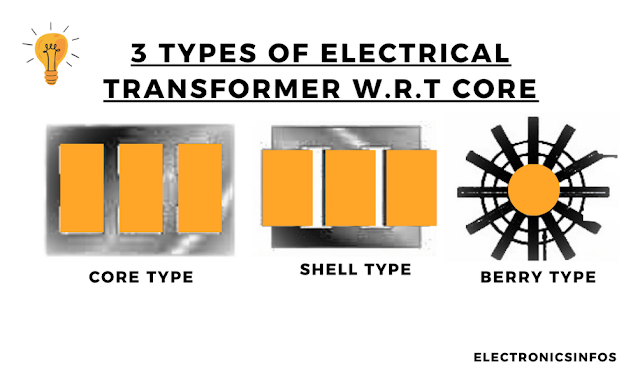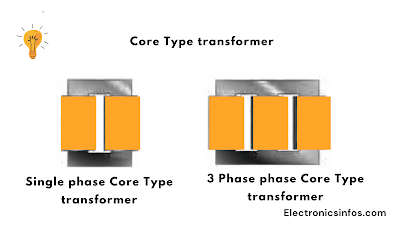What is the Importance of Core in the Transformer?
The core plays an important role in transformers due to its ability to transfer of energy between the primary and secondary windings. The core provides a closed magnetic circuit for the magnetic flux generated by the primary winding. The core material, typically made of laminated steel or iron, has high permeability, which allows it to concentrate the magnetic flux within the core. The core also provides structural support for the windings and helps maintain the insulation between the primary and secondary coils. There are Three types of transformers when we consider core including
Types of transformer W.r.t Core
- Core type
- Shell type
- Berry Type
Core type Transformer
A core-type transformer is one where the windings are wound around the core, creating a single path for the magnetic field. This design minimizes magnetic leakage. Both the winding and the core are overlapped to reduce the magnetic leakage. The core is typically made of laminated material to decrease eddy current losses. Core-type transformers are widely used due to their efficiency and reliability.
The coils in a core-type transformer are usually cylindrical, although circular or rectangular shapes are also common. Smaller core-type transformers are often built with rectangular or cylindrical forms, while larger ones use circular or cylindrical coils.
- Core-type transformers are mechanically strong.
- Core-type transformers have better cooling characteristics compared to shell-type transformers.
- Core-type transformers are well-suited for high-voltage applications.
- Core-type transformers are relatively easier to manufacture compared to shell types.
- Core-type transformers are used in distribution networks.
Shell type Transformer
A shell-type transformer has two paths for the magnetic field. The core surrounds the windings, which are inside. The coils are wound in layers, like a stack of discs, and insulated with paper. Shell-type transformers can be rectangular or distributed in shape.
Deciding between core-type and shell-type transformers depends on factors like cost, voltage and power ratings, weight, insulation needs, and heat distribution. Both types of transformers use laminated sheets in shapes like E, I, and L to achieve the desired performance.
- Shell-type transformers have better mechanical strength.
- The arrangement of windings and core in a shell-type transformer allows for efficient heat dissipation.
- The design of shell-type transformers minimizes magnetic leakage.
- Shell-type transformers produce less noise compared to core-type transformers.
Berry Type Transformer
- The core is strong and rigid.
- per kVA rating is minimised.
- The size and weight are minimised.
- At high operating flux, the iron losses are reduced.
- The manufacturing cost is low.
Related
Posts :
How to Reduce The Transformer Losses?
Single Phase Transformer Vs Three Phase
Transformer









0 Comments
please do not insert spam links